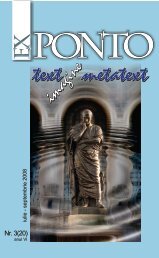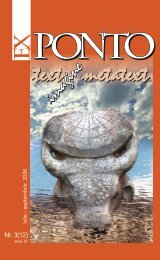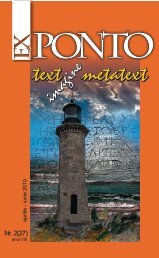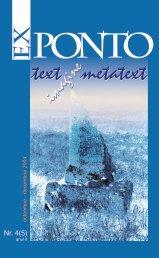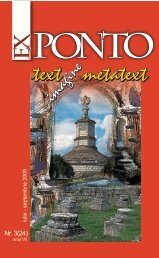Nr. 2 (19) anul VI / aprilie-iunie 2008 - ROMDIDAC
Nr. 2 (19) anul VI / aprilie-iunie 2008 - ROMDIDAC
Nr. 2 (19) anul VI / aprilie-iunie 2008 - ROMDIDAC
Create successful ePaper yourself
Turn your PDF publications into a flip-book with our unique Google optimized e-Paper software.
Gopo’s aesthetics of simplicity is basically an anti-Disney stance. Minimal<br />
lines merely suggest rather than represent character and story. Eliminating<br />
the richness of chromatic spectrum, the multitude of human expressions,<br />
and unnecessary descriptive details he succeeded in creating a comfortable<br />
ambiguity around his work. Dumitru Capoianu, the composer of the soundtrack,<br />
recalls, in an interview from 2004, that<br />
In all his movies, Ion Popescu-Gopo managed to fake out the censors. He<br />
succeeded in getting the film through the restrictions of the censorship, latching<br />
on to what was permissible and without arousing the authorities’ animosities<br />
and without alarming the ones who were watching. His production of films is<br />
like tight-rope walking. Against an argument attacking one of his sequences he<br />
always had a counter-argument, even in the same sequence. 7<br />
Ex Ponto nr.2, <strong>2008</strong><br />
Protected by his international success, Gopo’s ideas were not only<br />
tolerated by authorities, but also praised by party hacks. Mihnea Gheorghiu,<br />
for example, wrote enthusiastically about Gopo by applying the communist<br />
rhetoric to a sincere appraisal to emphasize their substantial contributions to<br />
Romanian culture. To play safe, Mihnea Gheorghiu himself had to identify the<br />
same major theme the censorship might have focused on in each of the works<br />
the office examined. “Progress,” “history of mankind,” its “crucial problems”,<br />
and “the rational artist” became words which meant almost nothing but the<br />
fact that the respective work met the ideological standards.<br />
Another relevant coincidence is the moment when the cartoon was<br />
broadcast in Romania. In <strong>19</strong>57, Romanians had only a couple of opportunities<br />
to see it: on TV, but chances were very low as TV sets had barely started<br />
selling in Romania, and in theatres, where, however, only the most educated<br />
used to go. In <strong>19</strong>63 when Gopo published his book Movies, Movies, Movies,<br />
the TV set became such a popular commodity that the import of TV sets<br />
increased by 51% since <strong>19</strong>60. The cartoon was broadcast either immediately<br />
before or after the publication of the book for the public to be able to connect<br />
them and “learn” the lesson the Office of Propaganda wanted them to get at<br />
that time: Romania had become a sovereign socialist country and its art had<br />
overcome the strict Zhdanovite aesthetics and conquered the West and beat<br />
the Russians, who otherwise were very hard to defeat. Since then, The Short<br />
History was broadcast many times under communism.<br />
Gopo created 14 more cartoons, directed 5 movies, and published many<br />
articles on animation and cinematography. He was never censored because<br />
he practiced self-censoring which prevented his works from being rejected by<br />
the Office of Censorship. Due to his ability to back up his work ideologically, the<br />
Romanian Communist Party even rewarded Gopo in its own way by inviting<br />
him to take part at the highest level of political meetings where the future of<br />
Romanian culture was decided. Such an invitation could not have been ignored<br />
or turned down. Although Gopo was not a collaborator and he was actually<br />
constantly watched by Secret Police, the Communist Party placed him in the<br />
same political forum alongside party hacks (a selection of the most infamous<br />
names: Suzana Gadea, Miu Dobrescu, Florea Ghita, Matei Ani, Viorica<br />
Neculau, Dumitru Radu Popescu) trying to suggest that Gopo might have<br />
been one of them. In <strong>19</strong>87, he participated in the Third Congress of Political<br />
Education and Socialist Culture and was among those who had to applaud and<br />
rhythmically cheer Ceausescu’s name. He also signed the documents issued<br />
164






